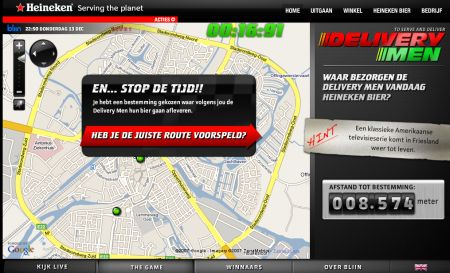von Roland Hachmann | Jan. 3, 2008 | Ad News, Blog, Digital Marketing, Online Advertising
The Wallstreet Journal published a list of the best and worst ad campaigns of 2007. Amongst the best were the ad campaigns of Dove, the Simpsons Movie, Cadbury. Some of the worst were bud.tv, General Motors, Snickers and Chrysler.
Interesting fact: while I have seen/read about all of the good ones, I know none of the bad ones. So even while being over here in Germany, I know (about) the good ads. And I did see / learn about them through traditional media. Get it?
von Roland Hachmann | Jan. 1, 2008 | Blog, Digital Marketing, Marketing Trends, Online Advertising, SEO / SEA, Social Media Marketing
I am impressed with this extensive list of web marketing areas by Jeremiah Owyang. It’s, as he calls it „A Complete List of the Many Forms of Web Marketing for 2008“ and for the moment it does indeed look very complete.
This document catalogs the many tools and tactics available for corporate web strategy in 2008. Even if your strategy or resource limitations restrict you from entering all spaces, awareness of the changes in our digital landscape are critical. This document is intended for decision makers roles such as CMO/VP/Director of Web and Marketing.
If anything, it shows that digital marketing has become a considerably large field of opportunities! At the same time it shows that there is still huge potential and opportunities for most companies out there.
von Roland Hachmann | Dez. 20, 2007 | Ad News, Blog, Digital Culture, Digital Marketing, Digital News, Marketing, Mobile Marketing, Online Advertising, Social Media Marketing
As every year around this time, all sorts of sites start to publish trends. Along the many lists that get published (and some of which I will subsequently link to), there is one selfproclaimed „Uber“-List, an aggregation of links of the main sites with trends. These trends do not only concern marketing and advertising, but also technology and internet trends.
It does sound a little like a link bait, but that’s fine for me as long as that lists gets updated frequently.
von Roland Hachmann | Dez. 20, 2007 | Ad News, Blog, Digital Marketing, Marketing, Online Advertising
This is a rather interesting online advertising approach from Norway:
One of Norways largest online news sources wanted to promote their online services. The idea: several copywriters comment live on the articles on the news portal, during the day and evening hours.

Within around 150 hours, more than 1,000 unique ads have been created this way. Enjoyable idea, and if the live comments by the copywriters were any good, people might have actually surfed the portal for quite some time just to read the ads…
von Roland Hachmann | Dez. 17, 2007 | Ad News, Blog, Digital Marketing, Marketing, Mobile Marketing, Online Advertising
Heineken in the Netherlands has launched a new advergame which looks interesting. The game asks playes to spot and track the delivery men of Heineken around the Netherlands and find out what their next stop will be. Whoever guesses correctly first, gets the chance to win a Nokia phone. So in a way, this game play is not that complicated or creative.

What I admire, is something completely different: Apparantly, these delivery men are tracked in real time with real journey data, during the regular working hours. And this is remarkable. I have also worked for clients with a huge fleet of delivery vehicles and I do appreciate the fact that Heineken managed to include their drivers into this game. Creatives usually come up easily with lots of brilliant ideas how to connect the mobile workforce of a client with a webpage via all sorts of mobile devices like phones or GPS tracking devices. But organisational reality most of the time kills these ideas.
So this won’t have been easy to push through the internal, most likely rather political, approval and commitment chain in order to get the buy in of all the different departments (marketing, distribution, logistics, etc.). Kudos, I like that.
(via)
von Roland Hachmann | Dez. 4, 2007 | Ad News, Blog, Digital Marketing, Marketing, Online Advertising
Mitch Joel blogs about advertising campaigns where the traditional campaign is long gone, but there still is a digital trail on YouTube and the likes, now leading to no longer existing microsites, etc.
In a traditional ad campaign, Marketers could get in and out in the span of a couple of weeks. Times have changed. The length of an ad campaign in the Digital Marketing space is dictated by the audience not by when the ad spend dies.
Interesting thought that has sparked a debate about purchasing the (digital) rights to media assets of integrated marketing campaigns. Here is my two cents which I put into Mitch’s comments:
Purchasing the rights to actors, directors, photography and such really depends on negotiations. I remember from my own experience that the guys at the classical advertising department were always shocked when they had to buy the rights for the internet, too. Because all of a sudden, they didn’t just buy the rights for, say, 1 year in Germany (in this case), but for world wide, because that is what the internet is: a medium that is globally accessible. It made each campaign relatively more expensive all of a sudden.
Just imagine what it will be like if they have to buy the rights not for Germany, and not for one year, but for worldwide, for ever!!
Advertisers won’t be able to not buy the digital rights. So the conclusion will have to be either: better rates in the contracts, or second rate actors, directors and photography. Not the most ideal setup.



 Wo ich sonst so bin...
Wo ich sonst so bin...